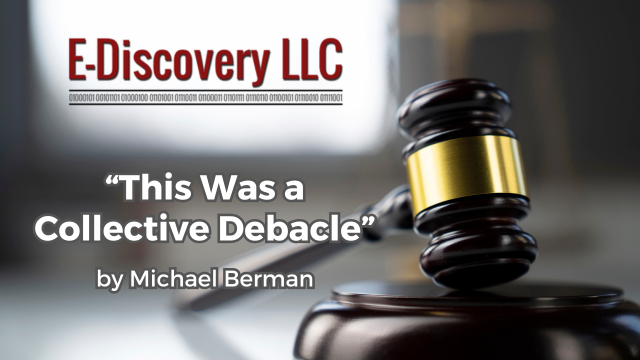
[EDRM Editor’s Note: The opinions and positions are those of Michael Berman.]
In Lacey v. State Farm General Ins. Co., 2025 WL 1363069 (C.D. Cal. May 5, 2025), plaintiff submitted a filing with erroneous AI-generated citations. The Special Master pointed out some of them. The plaintiff resubmitted a corrected filing; however, that second submittal still contained erroneous citations.
Two strikes and you’re out. The Special Master wrote: “[T]hey had the information and the chance to fix this problem, but didn’t take it.” Sanctions were imposed.
The Master wrote: “Although it’s necessary to identify some parties involved here, I decline to name-and-shame all of the lawyers in this order. They know who they are, and don’t need further notoriety here.” I have therefore redacted all names in this blog and replaced them with [AAAA], [BBBB], and [CCCC].
The Special Master wrote that:
1. The attorneys representing Plaintiff in this civil action submitted briefs to the Special Master that contained bogus Al-generated research. After additional proceedings and considerable thought, I conclude that an award combining litigation sanctions against Plaintiff and financial payments from the lawyers and law firms is appropriate to address this misconduct.
2. I also conclude that additional financial or disciplinary sanctions against the individual attorneys are not warranted. This was a collective debacle, and is properly resolved without further jeopardy. [Emphasis added].
Lacey v. State Farm General Ins. Co., 2025 WL 1363069 (C.D. Cal. May 5, 2025).
The scope of the problem was described by the Special Master as follows:
According to my after-the-fact review – and supported by the candid declarations of Plaintiff’s lawyers – approximately nine of the 27 legal citations in the ten-page brief were incorrect in some way. At least two of the authorities cited do not exist at all. Additionally, several quotations attributed to the cited judicial opinions were phony and did not accurately represent those materials. The lawyers’ declarations ultimately made clear that the source of this problem was the inappropriate use of, and reliance on, AI tools.
Id.
Plaintiff was represented “by a large team of attorneys at two law firms….” One of them, Mr. [AAAA], used AI to generate the “outline” for a filing. That is the document described above.
Mr. [AAAA] sent the outline to lawyers at [BBBB]. They incorporated the material into the brief. No attorney or staff member at either firm apparently cite-checked or otherwise reviewed that research before filing the brief with the Special Master. Based on the sworn statements of all involved (which I have no reason to doubt), the attorneys at [BBBB] didn’t know that Mr. [AAAA] used AI to prepare the outline; nor did they ask him.
Id.
The Special Master added:
A further wrinkle. During my initial review of Plaintiff’s brief, I was unable to confirm the accuracy of two of the authorities that the lawyers cited. I emailed the lawyers shortly after receiving the brief to have them address this anomaly. Later that day, [BBBB] re-submitted the brief without the two incorrect citations – but with the remaining AI-generated problems in the body of the text. An associate attorney sent me an innocuous e-mail thanking me for catching the two errors that were “inadvertently included” in the brief, and confirming that the citations in the Revised Brief had been “addressed and updated.” [Emphasis added].
Id.
The Special Master relied on Fed.R.Civ.P. 11 and 37, as well as the court’s inherent authority, to impose sanctions. The Master wrote:
With greater frequency, courts are now regularly evaluating the conduct of lawyers and pro se litigants who improperly use AI in submissions to judges. Whether that conduct supports the imposition of various types of sanctions requires a fact-and circumstance-specific analysis. See, e.g., United States v. Hayes, __ F.Supp.3d __, 2025 WL 235531 at *10-15 (E.D. Cal. Jan 17, 2025) (sanctioning criminal defense lawyer for using AI; when questioned by the court, the lawyer’s response about the source of inaccurate legal citations “was not accurate and was misleading”); Saxena v. Martinez-Hernandez, 2025 WL 1194003 at *2 and n.5 (D. Nev. April 23, 2025) (“Saxena’s use of AI generated cases – and his subsequent refusal to accept responsibility for doing so – is just another example of Saxena’s abusive litigation tactics, and further explains why the court issued case-terminating sanctions”) (collecting cases); United States v. Cohen, 724 F.Supp.3d 251, 254, 259 (S.D.N.Y 2024) (declining to find bad faith where defense lawyer voluntarily disclosed that she “had been ‘unable to verify’” false citations in colleague’s brief and lawyer acknowledged that he “would have withdrawn the [fake] citations immediately if given the opportunity”).
Id.
The Special Master’s explanation is important. During the sanctions process, the attorneys “included profuse apologies and honest admissions of fault.” Nevertheless:
The initial, undisclosed use of AI products to generate the first draft of the brief was flat-out wrong. Even with recent advances, no reasonably competent attorney should out-source research and writing to this technology – particularly without any attempt to verify the accuracy of that material. And sending that material to other lawyers without disclosing its sketchy AI origins realistically put those professionals in harm’s way.
Lacey v. State Farm General Ins. Co., 2025 WL 1363069 (C.D. Cal. May 5, 2025).
I conclude that the lawyers involved in filing the Original and Revised Briefs collectively acted in a manner that was tantamount to bad faith. Fink, 239 F.3d at 994. The initial, undisclosed use of AI products to generate the first draft of the brief was flat-out wrong. Even with recent advances, no reasonably competent attorney should out-source research and writing to this technology – particularly without any attempt to verify the accuracy of that material. And sending that material to other lawyers without disclosing its sketchy AI origins realistically put those professionals in harm’s way. Mr. [AAAA] candidly admitted that this is what happened, and is unreservedly remorseful about it.
18. Yet, the conduct of the lawyers at [BBBB] is also deeply troubling. They failed to check the validity of the research sent to them. As a result, the fake information found its way into the Original Brief that I read. That’s bad. But, when I contacted them and let them know about my concerns regarding a portion of their research, the lawyers’ solution was to excise the phony material and submit the Revised Brief – still containing a half-dozen AI errors. Further, even though the lawyers were on notice of a significant problem with the legal research (as flagged by the brief’s recipient: the Special Master), there was no disclosure to me about the use of AI. Instead, the e-mail transmitting the new brief merely suggested an inadvertent production error, not improper reliance on technology. Translation: they had the information and the chance to fix this problem, but didn’t take it. Cohen, 724 F.Supp.3d at 259. [Emphasis added].
Id.
The findings are cautionary:
I therefore conclude that (a) the initial undisclosed use of AI, (b) the failure to cite-check the Original Brief, and (perhaps most egregiously), (c) the re-submission of the defective Revised Brief without adequate disclosure of the use of AI, taken together, demonstrate reckless conduct with the improper purpose of trying to influence my analysis of the disputed privilege issues. The [CCCC] and [BBBB] firms had adequate opportunities – before and after their error had been brought to their attention – to stop this from happening. Their failure to do so justifies measured sanctions under these circumstances.
Id.
I therefore conclude that (a) the initial undisclosed use of AI, (b) the failure to cite-check the Original Brief, and (perhaps most egregiously), (c) the re-submission of the defective Revised Brief without adequate disclosure of the use of AI, taken together, demonstrate reckless conduct with the improper purpose of trying to influence my analysis of the disputed privilege issues.
Lacey v. State Farm General Ins. Co., 2025 WL 1363069 (C.D. Cal. May 5, 2025).
As a sanction, several briefs on the privilege issue were stricken and other discovery relief sought by plaintiff was denied.
I conclude that these non-monetary sanctions will suffice to “deter repetition of the conduct or comparable conduct by others similarly situated.” Fed. R. Civ. P. 11(c)(4). If the undisclosed use of AI and the submission of fake law causes a client to lose a motion or case, lawyers will undoubtedly be deterred from going down that pointless route.
Id.
Special Master fees of $26,100 were assessed against plaintiff plus defense costs of $5,000. The Special Master wrote: “In a further exercise of discretion, I decline to order any sanction or penalty against any of the individual lawyers involved here. In their declarations and during our recent hearing, their admissions of responsibility have been full, fair, and sincere. I also accept their real and profuse apologies. Justice would not be served by piling on them for their mistakes.”
The Special Master wrote:
A final note. Directly put, Plaintiff’s use of AI affirmatively misled me. I read their brief, was persuaded (or at least intrigued) by the authorities that they cited, and looked up the decisions to learn more about them – only to find that they didn’t exist. That’s scary. It almost led to the scarier outcome (from my perspective) of including those bogus materials in a judicial order. Strong deterrence is needed to make sure that attorneys don’t succumb to this easy shortcut.
Id.
It almost led to the scarier outcome (from my perspective) of including those bogus materials in a judicial order. Strong deterrence is needed to make sure that attorneys don’t succumb to this easy shortcut.
Lacey v. State Farm General Ins. Co., 2025 WL 1363069 (C.D. Cal. May 5, 2025).
The decision includes supporting documentation. One attorney’s Declaration, for example, stated: “In short, our process broke down at several levels across both firms. And as the most senior lawyer on our collective team — whether cite-checking was my responsibility or not — I accept responsibility for (1) not alerting my colleagues with respect to the tools I utilized in conducting the initial research; and (2) failing to conduct cite-checking myself or to specifically request that the brief be properly reviewed for citation errors; and (3) not adequately supervising the cite-checking process. I am both deeply apologetic and embarrassed by this error…. Not at any time was there a deliberate effort to deceive or falsify the state of the law, nor did we.”
The Declaration provided an errata sheet, “irrespective of whether these errors are associated with the use of AI, or not….”
See generally “MyPillow Attys Blame Filing Error After Judge Suspects AI Use” (May 5, 2025)(one attorney said that he did not know that his co-counsel had mistakenly filed a draft).
Assisted by GAI and LLM Technologies per EDRM GAI and LLM Policy.


